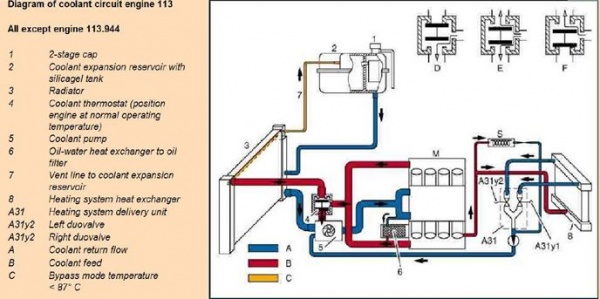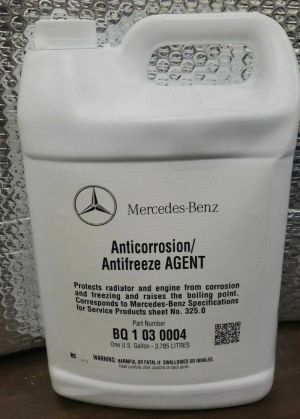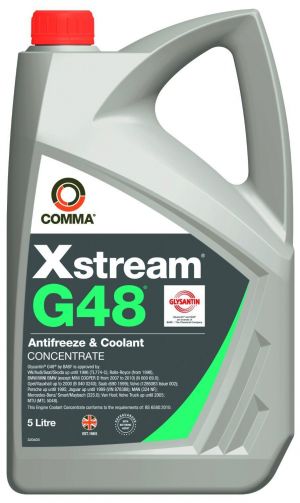WIS 20.00 General: Difference between revisions
Ricebubbles (talk | contribs) mNo edit summary |
(→Coolant: described different specs and their capability) |
||
| (4 intermediate revisions by 2 users not shown) | |||
| Line 1: | Line 1: | ||
Back to '''[[Index]]''' | |||
==M113 Engine Cooling System== | ==M113 Engine Cooling System== | ||
===Coolant Diagram - M113 Engine Cooling System=== | ===Coolant Diagram - M113 Engine Cooling System=== | ||
| Line 7: | Line 9: | ||
* OEM Coolant is supposedly good for 250,000Km or 15 Years. | * OEM Coolant is supposedly good for 250,000Km or 15 Years. | ||
* M-B DIY enthusiasts typically change the coolant every 3 - 5 years. | * M-B DIY enthusiasts typically change the coolant every 3 - 5 years. | ||
* For other issues such as leaking hoses and pipes see [[WIS 20.20 Radiator, Coolant Hoses]]. | |||
==Coolant == | |||
The capacity of the cooling system is 11.2L. | |||
There are 3 types of MB approved anti freeze liquids: | |||
* BQ1030002 (G05) yellow (MB 325.1 spec) | |||
* BQ1030004 (G48) dark blue/green (MB 325.0 spec) | |||
* BQ1030005 (G40) pink (MB 325.6 spec) | |||
{| | |||
|[[File:MB_325.0_coolant.jpg|thumb|none|OE MB 325.0 coolant]] | |||
|[[File:XSTREAM_G48_coolant.jpg|thumb|none|XTREAM G48 (MB-approved MB 325.0 coolant)]] | |||
|} | |||
The yellow coolant (G05) was the original coolant that Mercedes used ~20 years ago. | |||
Today, Mercedes recommends to use the blue coolant according to spec '''MB 325.0 ''' (G48) in MB passenger vehicles up to and including the year of manufacture April 2014. | |||
The yellow (G05) and blue (G48) coolants are compatible - both are GOAT type formulas. However, the yellow coolant hasn't been used for at least ten years now. | |||
''' | The pink coolant is the latest '''MB 325.6''' (G40) spec (Borate-free Si-OAT type formula) that can be used in the older engines, but only after all of the old (yellow/blue) coolant has been thoroughly flushed out of the system (they have different chemistries that are not compatible and if mixed will cause damage in pretty short order). | ||
[[ | Mercedes maintains a list of coolants that are approved by MB and confirm to [https://operatingfluids.mercedes-benz.com/sheet/325.0| MB 325.0] and [https://operatingfluids.mercedes-benz.com/sheet/325.6| MB 325.6] specifications. | ||
=== Mixing coolant with water === | |||
Make sure that the anti-corrosion / antifreeze agents are mixed as a concentrate (MB sheets 325.x) with suitable water in accordance with the specifications of MB sheet 310.1 before use in the cooling circuit. Corrosion / antifreeze agents as a ready-made mixture (MB sheets 326.x) must not be mixed with water for use. | |||
==DIY Basic Coolant Change - M113 Engine Cooling System== | |||
This is the basic DIY Coolant Change Technique for Flushing and Refill: | This is the basic DIY Coolant Change Technique for Flushing and Refill: | ||
* ONLY open the system with engine temperature less than 90C, and do it SLOWLY. | * ONLY open the system with engine temperature less than 90C, and do it SLOWLY. | ||
| Line 40: | Line 56: | ||
===DIY Radiator Coolant and Pressure Test - M113 Engine Cooling System=== | ===DIY Radiator Coolant and Pressure Test - M113 Engine Cooling System=== | ||
This is the thorough DIY Coolant Change Technique for Flushing and Refill: | |||
http://www.benzworld.org/forums/w140-s-class/1444114-photo-diy-coolant-service-la-vacuum.html | http://www.benzworld.org/forums/w140-s-class/1444114-photo-diy-coolant-service-la-vacuum.html | ||
Latest revision as of 12:14, 27 February 2024
Back to Index
M113 Engine Cooling System
Coolant Diagram - M113 Engine Cooling System

Issues - M113 Engine Cooling System
- OEM Coolant is supposedly good for 250,000Km or 15 Years.
- M-B DIY enthusiasts typically change the coolant every 3 - 5 years.
- For other issues such as leaking hoses and pipes see WIS 20.20 Radiator, Coolant Hoses.
Coolant
The capacity of the cooling system is 11.2L.
There are 3 types of MB approved anti freeze liquids:
- BQ1030002 (G05) yellow (MB 325.1 spec)
- BQ1030004 (G48) dark blue/green (MB 325.0 spec)
- BQ1030005 (G40) pink (MB 325.6 spec)
 |
 |
The yellow coolant (G05) was the original coolant that Mercedes used ~20 years ago.
Today, Mercedes recommends to use the blue coolant according to spec MB 325.0 (G48) in MB passenger vehicles up to and including the year of manufacture April 2014.
The yellow (G05) and blue (G48) coolants are compatible - both are GOAT type formulas. However, the yellow coolant hasn't been used for at least ten years now.
The pink coolant is the latest MB 325.6 (G40) spec (Borate-free Si-OAT type formula) that can be used in the older engines, but only after all of the old (yellow/blue) coolant has been thoroughly flushed out of the system (they have different chemistries that are not compatible and if mixed will cause damage in pretty short order).
Mercedes maintains a list of coolants that are approved by MB and confirm to MB 325.0 and MB 325.6 specifications.
Mixing coolant with water
Make sure that the anti-corrosion / antifreeze agents are mixed as a concentrate (MB sheets 325.x) with suitable water in accordance with the specifications of MB sheet 310.1 before use in the cooling circuit. Corrosion / antifreeze agents as a ready-made mixture (MB sheets 326.x) must not be mixed with water for use.
DIY Basic Coolant Change - M113 Engine Cooling System
This is the basic DIY Coolant Change Technique for Flushing and Refill:
- ONLY open the system with engine temperature less than 90C, and do it SLOWLY.
- Drain old coolant using Radiator Drain Plug (and engine block drain plugs if they exist).
- Dispose of the Coolant per your Local regulations, even though it is classified as "Biodegradable".
- Fill with rain water using Vacuum Filling System to remove trapped air bubbles. (Takes about 6-7L.)
- Drain again.
- Repeat fill with rain water and drain several more times until drained fluid is clear. (On last few drains, use Vacuum System without filling to remove deep trapped air bubbles.)
- Then fill with distilled water using Vacuum Filling System. (Takes about 6-7L.)
- Drain once more. (Use Vacuum System several times without filling to remove deep trapped air bubbles.)
- If using M-B coolant add as much as system will take using Vacuum Filling System.
- If using antifreeze concentrate add 6L of concentrate using Vacuum Filling System.
- Top up with distilled water.
- After all air has escaped top up with either M-B coolant or distilled water as required.
- Final Concentration using antifreeze concentrate should be 6L in 11.2L ie 54%.
- Note if you do a "complete" coolant change every 2 - 3 years, there is probably no need to do the several rain water and distilled water flushes.
DIY Radiator Coolant and Pressure Test - M113 Engine Cooling System
This is the thorough DIY Coolant Change Technique for Flushing and Refill:
http://www.benzworld.org/forums/w140-s-class/1444114-photo-diy-coolant-service-la-vacuum.html
Temperature Sensors - M113 Engine Cooling System
TBA
Here are some typical M-B thermistor resistance values made at a given temperature. The tests were conducted on a W204 2008 C220 but are representative of all M-B Thermistors.
- Temperature sensor near the water pump (A311 01:09) with a green dot at 18°C it had a resistance of 2.36K Ohms. When warmed slightly with a heat gun the resistance dropped to 1.48K Ohms.
- Temperature sensor in the thermostat housing (B11/4) at 18°C B11/4 had a resistance of 2.81K Ohms. When warmed slightly with a heat gun the resistance of B11/4 dropped to 1.15K Ohms.